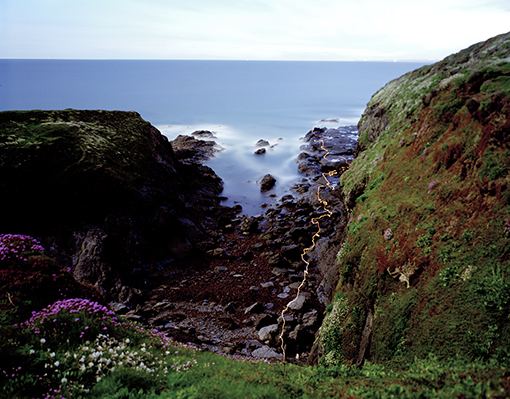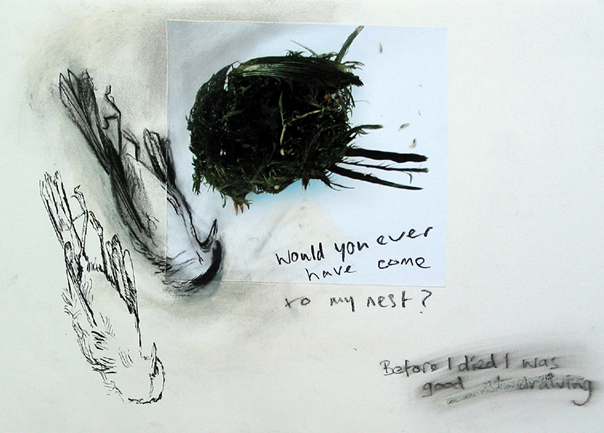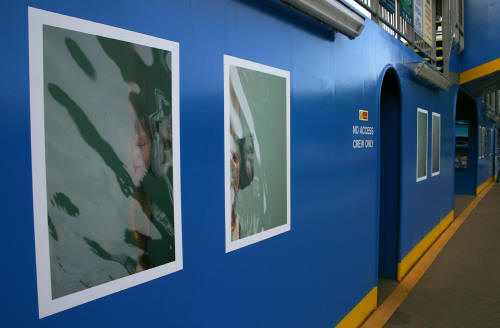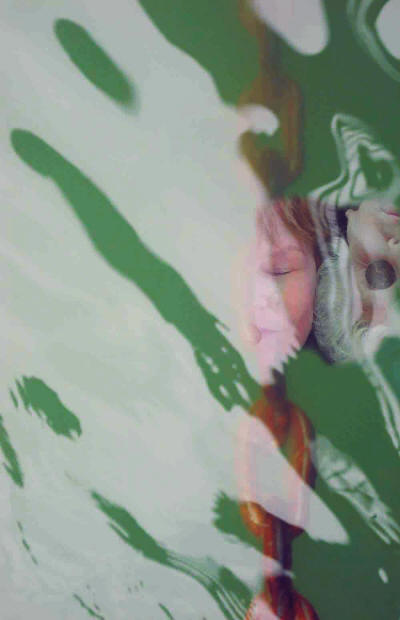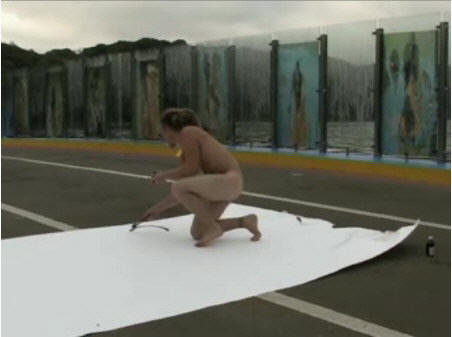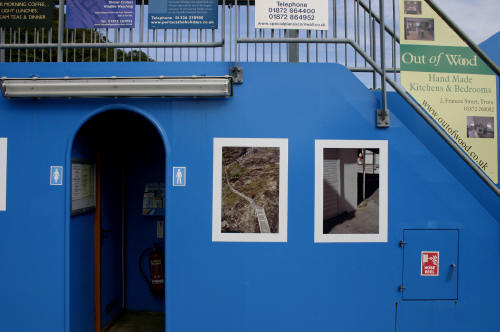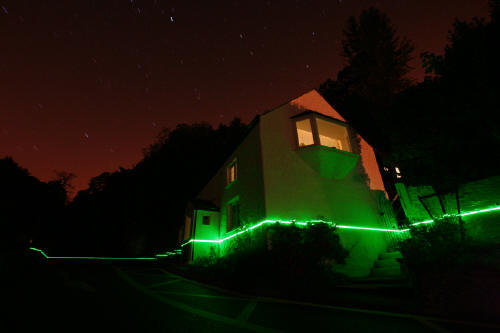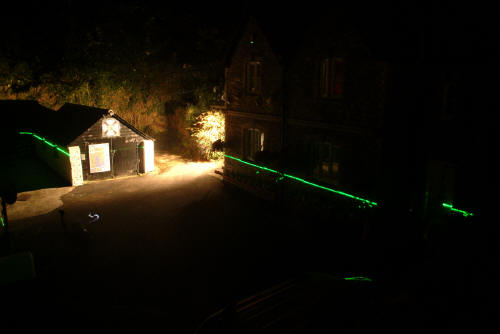|
|
||
| home | features | exhibitions | interviews | profiles | webprojects | gazetteer | links | archive | forum | ||
|
|
||
|
Embark: Ferry art A project curated by CAN (Cornwall Artists Network)
Photographs cannot capture the unique charm of the King Harry Ferry as it graciously shuttles cars and their drivers between the two banks of the Truro River linking Feock (Trelissick) and the Roseland peninsular. The waiting queue of traffic and foot passengers; the sound of water lapping, chains clanking and river birds squawking; the salty smell of the mud, oil and seaweed: all combine to gently assault the senses and create a setting for an art show that is like no other.
It is a setting that poses a special challenge because of its scale and grandeur. For example there is always the danger that art placed in this kind of context will appear like an unnecessary distraction. And yet, despite being open to the elements, the Ferry itself is a similar size to a gallery. In addition the people on it, who are free to leave their cars and wander about, are a captive audience; captive at least for the 6 or 7 minutes the Ferry takes to carry them to the opposite bank.
James Hankey (April) James Hankey was the first of the artists to be exhibited as part of 'Embark'. Over the last few years - whilst a student at Falmouth University College and subsequently - Hankey has developed an impressive body of work comprising photographs of the landscape taken at night using long exposures, and marked by trails he has left whilst walking through them with a torch.
The result is a fascinating and magical new take on the idea of walking as a means of marking both time and space. These notions are familiar particularly through the work of British artists like Richard Long and Hamish Fulton, and it was nice to see them revisited in a different, local, context. The photos shown as part of Embark were taken on the Lizard in Cornwall.
Stephanie Boon (May) Boonís collages, which were featured in May, were all intensely melancholy reflections on mortality using drawn and photographed images of dead birds. In a different context these images could seem almost too painful and disturbing to enjoy, but in the context of this open-air gallery space they worked well to connect the psyche of the artist with the specificities of the location. The subject matter seemed to speak of both with equal force, and the balancing of the two elements gave the work poise and energy.
This intrusion of personal narrative into a largely natural space using the metaphor of the birds, was understood and appreciated by most visitors. Others responded more concretely however, and complained to the owners of the ferry. In fact the complaints generated publicity and led to Boon subsequently being interviewed on Westcountry TV.
Allesandra Ausenda (June) In classical antiquity it was customary to place a coin on the mouth or eyes of the dead, in order the pay Charon, the boatman to carry them across the river Styx to the afterlife. Although Ausenda's work linked the modern car ferry to its mythical ancestor, the images she used were not in the least macabre. Photos of herself and her relatives were placed alongside each other, in peaceful repose, as if, in death, they were merging with each other and with the seductive green waters around them.
The blending was done digitally, which created an uncanny realism, and the overall effect in this setting was to set into play a chain of metaphors that linked the work to the environment of the river.
Hayley Gearon (July) Hayley Gearonís contribution to the ongoing Ferry Art Project had some similar themes to the previous Embark show Ė with human figures appearing to blend and become one with their surroundings. In this case instead of a digital montage, the subjects were actually photographed at the waters edge, their clothes wet and muddied, emerging drenched with water as if survivors of a wreck at sea. The processing came later, with images being spliced together like jigsaw pieces, to create hybrids or Ďchimerasí. These were mounted as life-sized semi-opaque photographs on the glass wall of the Ferry looking towards the sea, so that the estuary itself became the backdrop to the artwork, and the figures ghostly, and indefinite.
Lit from behind by a milky white light, Gearonís photographs had an undercurrent of violence and drama, and looked like stills from a film. The emotional tone, which was offset to a degree by her chosen colour palette, was important to the work, as there was little in the way of overt symbolism to help reveal the meanings contained within. It should be said, however, that this was the month of the highly publicised floods in Gloucester, Tewkesbury and the Oxfordshire region, which provided some alternative, if unplanned, readings for the work.
Charles Napier (August) Charles Napierís proposal for Embark involved painting two swans on a giant roll of paper. To the surprise of the Ferry staff, however, he did so completely naked. Arriving, already unclothed, on the ferry in a red pick-up truck, he started by placing the rolls of paper between two poles, but when one blew down he continued - undeterred - painting the outline of the birds, each one four or five feet high. He finished the performance by climbing though a hole in the paper, before returning to his car and driving away.
Charles Napierís work was never shown on the Ferry, as it was considered too problematic and potentially offensive to customers. In every respect his nudity proved the most salient and significant feature of the work, and certainly the aspect that provoked the strongest reaction. From Benny Hill, to the naked rambler, there is something funny about male nudity. Napierís video is the kind of work that initially provokes embarrassed laughter in those not left bewildered by it. Much of the impact of the piece was because it took place in such a public, yet peaceful, and 'unspoilt' space. This made the nudity seem both gratuitous and surreal, in a way that to some is threatening or sacrilegious. Subsequent viewings of the video emphasise other more subtle aspects, however, such as the tenderness and poetry of the piece, via references to eg Leda and the Swan, and the logic of the performance being made in exactly the same time it takes the Ferry to cross the river. see 'webprojects' for the video itself
Tim Mills (September)
Whilst the female artists involved in Embark made work which was more autobiographical in nature, the male artists showed images that were more detached, and only obliquely related to their personal lives. Mills, with his collection of semi-documentary photos, took this tendency the furthest. The images he showed were pictures of Cornwall taken out of the tourist season, when it is often cold and overcast. The scenes, although familiar and everyday, are framed and edited in a way that the eye scans them differently, and picks up detail that might otherwise be missed.
But this is a minor feature of the work. More significant for its character, are the decisions made regarding the actual subject matter. The images that carry the most charge are those of visitors braving the dubious delights of Ďattractionsí like the complex at Lands End. They are compelling because they are a potent reminder of the harsh reality of Cornwall as a tourist attraction: a reality that is not usually visible in the carefully stage-managed representations of Cornwall used to market the county in glossy life-style magazines. Not only is it the political dimension of these works which gives them extra value, it is their placement on the Ferry. The Ferry is quite visually cluttered, and in particular there is the problem of the advertising boards that compete for visitorsí attention only a few feet away. Millsí photographs, in providing at some level a critique of tourist advertising, turn this to his advantage; and in the process carry out a thrilling if discrete act of rural ad-busting. In Cornwall, at the moment, this is a project that is long overdue and worthy of further exploration and development.
Paul Chaney (October) 'Embark - Ferry Art' was bracketed by series of photographs taken after nightfall, with Paul Chaney's exquisite night-time shots echoing a theme first stated by James Hankey in April. But whilst Hankey referenced British land artists in his work, Chaney bypassed such allusions in pursuing a subject more directly related to environmental concerns.
The title 'Mark of Extraordinary Tides' was derived from the age-old practice of marking the height of 'ordinary tides' on maps and sea-charts. Chaney's mark, however, was a glowing green line hundreds of metres long, made by a spinning laser placed in a number of valleys and creeks in the vicinity. The line, which seemed ethereal and futuristic, was several feet higher than the existing tideline, so that it ranged across trees, rocks and houses at a level that approximated to the height of tides predicted as a result of global warming. Chaney's was one of the strongest of the Embark exhibits, not only because of its beauty, but because of its simple, direct message, derived itself from a consideration of the specific nature of the location.
Some parts of the county have been depicted by artists so many times, that art made there now struggles to breathe freely, and wrench itself away from old art-historical references and cliches. There are, in contrast, plenty of other locations that also deserve being given attention, and 'Embark: Ferry Art' demonstrated the value of doing so*. It was good, therefore, to see a collection of work that utilised aesthetic and environmental features specific to the area, and set in motion a new set of meanings and associations for it.
*Not that the Feock area of Carrick is without its own art-heritage. On Ben Nicholson's first visit to Cornwall he stayed in Pill Creek with Christopher Wood and Winifred Nicholson, in a house that was later rebuilt by Richard Rogers and Norman Foster. In addition, the King Harry Ferry itself is within a couple of miles of the farmhouse owned by Roland Penrose in which Man Ray and Lee Miller used to stay (see gazetteer: Lambe Creek).
|
||

